Super Food, Super You!

You Are What You Eat!
Join me to get clear on how you can regain your optimal fuel and health by incorporating superfoods into your diet at my next webinar, Superfood, Super You on Saturday, August 18th at 1:00 pm CDT Register here to save your spot: Superfood, Super You Seminar
Hosted by:
Salena Rothenberger, D.PSc, CFMP, CHC
What Are Superfoods?
Superfoods are universal! Every culture throughout recorded human history has identified certain indigenous foods to have superior health-promoting nutrition.
For a food to be considered a superfood, it must contain significant amounts of a variety of healthful bio-available nutrients (usable by the body in the form it is ingested). This may be vitamins, minerals, antioxidants, phytonutrients, or beneficial macronutrients. This basically means all we have to do to reap their benefits is eat it!
Why Do We Need Them?
The American diet is nutrient poor and calorie dense. This leads to a lot of undernourished and unhealthy people while uprising trends in obesity, depression, and chronic illnesses. This diet of processed foods creates a welcoming environment for inflammatory cells that promote disease which creates an endless cycle.
Luckily, superfoods have the ability to stop inflammation in its tracks, and in some cases, can even reverse existing cell damage!
Superfoods provide us with the nutrition our bodies need AND strengthen our immune system like none other.
During this experience, you will gain clarity on what makes a superfood truly earns its title, how you can incorporate them into your diet, and how they can optimize your health!
Invite the people you care about most to my webinar, Superfood, Super You, to learn ways to take control of our diet, health, and life!
Now that you know you can make a change, will I see you there?
This is guaranteed to be incredible!
We Can’t Wait to Share With You on Saturday, August 18th at 1:00 pm CDT!
GUEST POST: Is Reactivated Epstein-Barr Causing Your Chronic Fatigue Syndrome? Here is How To Tell (And What To Do About It)

Today I have a special guest, a very passionate functional medicine colleague who helps women with chronic fatigue syndrome reclaim their energy, joy & clarity so they can truly thrive again. She has been generous to share with us this great information, my hope is it can benefit you or someone you love who is challenged with Chronic Fatigue Syndrome! Here’s Laura!

Hey there! My name’s Laura. I’m a certified functional medicine practitioner over at www.lauraditri.com and I specialize in helping women fully recover from Chronic Fatigue Syndrome (CFS) and get their lives and their health back.
Some research has suggested reactivated Epstein-Barr Virus plays a role in CFS, although findings are somewhat controversial. Clinically, however, I find reactivated EBV is at least partially responsible (and sometimes completely responsible) for CFS in around 30% of the women I work with.
Epstein-Barr is the virus that commonly causes mononucleosis, a.k.a. “mono” or glandular fever, but it can stay in the body and silently wreak havoc long after the mono phase is over. This virus can live in someone for decades, sneaking in and out of activity because of stress or other imbalances in the body.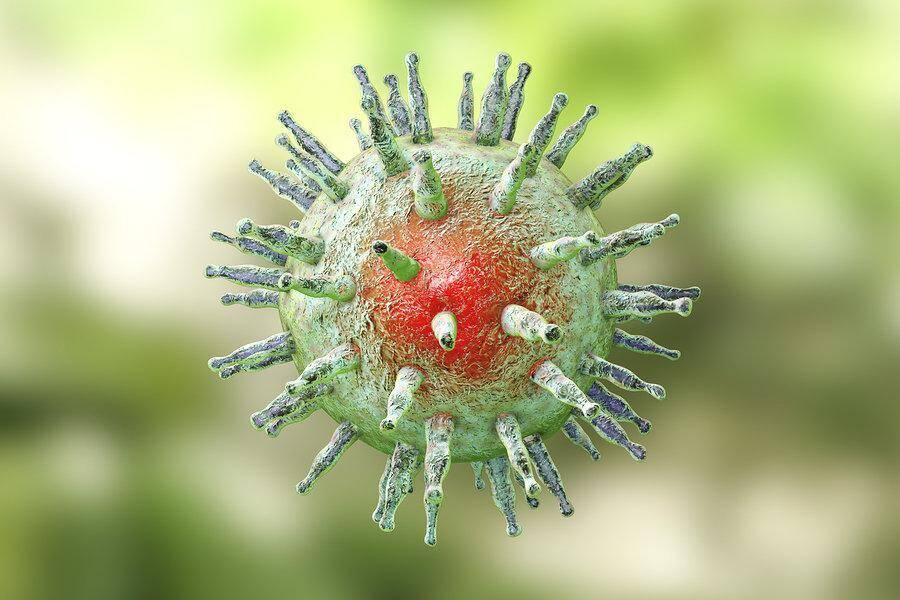
Reactivated Epstein-Barr can cause
- fatigue/exhaustion
- anxiety and depression
- systemic inflammation
- muscle and joint pain
- brain fog
- swollen glands in the neck
- Hashimoto’s or hypothyroidism
- and it is linked to multiple other autoimmune diseases and even certain cancers
Reactivated EBV is often misdiagnosed. New research shows a link between reactivated EBV and fibromyalgia, Lyme disease, and possibly chronic fatigue syndrome.
By the time you are done reading this article, you will know exactly how to test for Epstein-Barr and interpret your results AND you’ll also learn my tried-and-true strategies for recovering.
First, talk with your doctor or practitioner about getting a lab that shows all four EBV antibodies. These antibodies include EBV VCA IgG, EBV VCA IgM, EBV EBNA IgG, and EBV EA IgG.
If you aren’t currently working with a doctor, you can order this full panel from http://www.walkinlab.com
So as to not overwhelm you, I’m going to add this in as a side note: It’s possible to get a “false negative” on your results if your total immunoglobulin G + M are less than normal. You can foolproof this a bit more by asking your doctor to order “Quantitative Immunoglobulins G + M” to add to your panel. This is how I order it in my clients so we make sure results are that much more accurate.
Interpretation of the EBV blood test in the way I’ll describe is pretty accurate, but not 100% accurate according to the medical literature. There are no definitive results when it comes to most lab tests, but these four antibodies give us a pretty good picture.
Once you have your results back, take a look at this chart from Newfoundland and Labrador Public Health Library: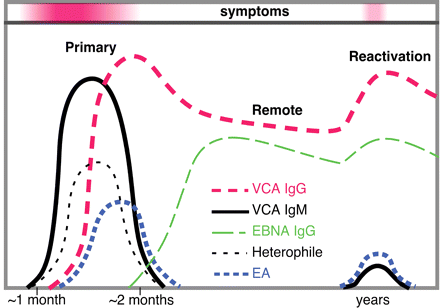
You want to pay attention to “reactivation” on the right-hand side. The EA IgG (blue dotted line) is the most important ones to look at in terms of reactivated EBV. It has been shown to be elevated in 10 out of 11 cases of reactivated EBV. Its possible yet rare that EA can be negative, however, and there will still be a chronic infection.
I find VCA IgM is rarely raised in reactivation and is usually raised in initial infection only (mononucleosis/glandular fever).
A typical picture of reactivation will be elevated EA IgG, VCA IgG, and EBNA IgG.
A less typical picture of reactivation will be either the VCA IgG or the EBNA IgG markers (or both) being above 100 U/mL, and the EA IgG and VCA IgM markers being in normal range. This generally means the testing was done in a “lull” phase of reactivation but the virus is prone to reactivating. I would still recommend using anti-viral herbs and supplements, as many with this picture feel infinitely better once they follow an anti-viral protocol for a few months.
Also keep in mind that the EA IgG marker is also elevated in 20 – 30% of patients that are perfectly healthy now but did have a past Epstein-Barr infection like mononucleosis. If you’re reading this article and ordering this test because you have EBV symptoms, you’re likely not in this 20 – 30%… but it’s still good to keep this in mind for re-testing.
Which Supplements And Herbs Get Rid Of EBV?
Now that you know if you’re likely dealing with reactivation of EBV, let’s take a look at specific, scientifically studied botanicals and supplements to help get rid of it.
Note that the goal of recovering from reactivated EBV is to get the virus to go back into a “dormant” state.
Multiple different vitamins and minerals have scientific links showing their benefit to boosting up the immune system to attack viruses. These include vitamin A, D, methylated B12, C, and zinc.
The best direct anti-viral herbs and supplements for EBV include boswellia, turmeric, ginger, licorice (not DGL), selenium, alpha lipoic acid (caution if you have amalgam/mercury fillings), CBD oil, baicalin/Chinese Skullcap, passionflower, reishi, berberine, and lysine.
The best herbs and supplements to support methylation and detoxification for EBV include Hawaiian spirulina, NAC, P5P, and methyl groups such as SAMe, methyl-, adenosyl-, and hydroxycobalamin.
I generally recommend incorporating standard daily values of vitamin A, D, and zinc, although more may be needed if a blood test shows a deficiency. If alkaline phosphatase (part of a standard blood test) is lower than 70 u/l, that is generally a fairly good indication of zinc deficiency. I recommend incorporating fairly large doses of vitamin C and B12 as they are water soluble and can be taken in higher concentrations than vitamins A and D without risk of toxicity.
For the direct anti-viral herbs and supplements, I recommend starting with a heavy dose of 3-5 of these products and rotating or adding in as you recover.
Supporting methylation and detoxification is usually necessary as genetics play a role in these processes as well. It’s especially important if you have the MTHFR gene. So as not to overdo it with supplements, I generally recommend just 1-2 of the methylation & detoxification products at a time.
Foods To Eat & Not To Eat
For reactivated EBV, one of the most import things you can do is to follow a no-egg anti-inflammatory diet.
Inflammation causes stress. Stress wreaks havoc on the adrenals. When the adrenals are in bad shape, the immune system takes a hit, and EBV is more prone to becoming out of control.
My favorite anti-inflammatory diet is what I like to call a “high-vegetable” gluten-free & dairy-free diet. I recommend at least four cups of vegetables per day, as their high antioxidant content is important for normalizing detox processes in the body. If tolerated raw, the beneficial soil-based microorganisms found on them will help to repopulate the microbiome of the digestive tract as well. I also recommend staying away from eggs, as EBV increases the likelihood of egg allergies.i
Go organic. Especially for meats and animal products. Organic food has been proven to be much more nutrient and antioxidant denseii than non-organic food. This is incredibly important to heal the cellular processes of the body, not to mention the relief your detox pathways will feel when they don’t have to detox and process pesticides and herbicides.
Organic, grass-fed, and free-range meats and animal products have a completely different nutrient and omega profile than conventionally raised animal products, and generally tend to be anti-inflammatory (as opposed to conventionally raised animal products which tend to be pro-inflammatory).
It’s incredibly important to note that “killing” the EBV virus is just the first step. The bigger picture is bringing your body back into a state of balance so the immune system isn’t compromised and the EBV doesn’t take over again. In the greater picture of so many conditions that tend to have “layers” like chronic Lyme, reactivated EBV, adrenal fatigue, hormone imbalance, and Chronic Fatigue Syndrome (CFS), its incredibly important to make sure not only are you killing the bad guys, but also supporting detox and methylation pathways, understanding if gut bugs are present, if environmental or mold illness is a factor, if food allergies are present, if autoimmunity against the thyroid or other organs is at play, and if there’s systemic inflammation that’s halting the healing process.
Reactivated EBV can start to turn around in as little as 2 weeks, although many need a longer-term program that lasts multiple months to notice a huge difference. If you are on the right track, you should see your antibodies decrease after 2 months.
After this time, go back to step one and retest yourself for EBV antibodies. If you’re moving in the right direction, your antibodies (ANY of the four) should go down. Of course, the most important part is to get you feeling radically better, but seeing absolute proof that what you are doing is working can be a wonderful support!
As with any advice you read on the internet, this info is for educational purposes only. Before implementing any changes in your diet/lifestyle/supplement routine, be sure you talk with your own doctor to understand if these suggestions are appropriate for you.
All the best in your radical recovery from reactivated EBV,
Laura
www.lauraditri.com
References:
1 Loebel (2014) Deficient EBV-specific B- and T-cell response in patients with chronic fatigue syndrome.
https://www.ncbi.nlm.nih.gov/pubmed/24454857
2 Fagundes (2014) Attachment anxiety is related to Epstein-Barr virus latency.
https://www.ncbi.nlm.nih.gov/pubmed/24945717
3 Esterling (1993) Defensiveness, trait anxiety, and Epstein-Barr viral capsid antigen antibody titers in healthy college
students. https://www.ncbi.nlm.nih.gov/pubmed/8500440
4 Onozawa (2017) Inflammatory cytokine production in chronic active Epstein-Barr virus infection.
https://www.ncbi.nlm.nih.gov/pubmed/28381684
5 Janegova (2015) The role of Epstein-Barr virus infection in the development of autoimmune thyroid diseases.
https://www.ncbi.nlm.nih.gov/pubmed/25931043
6 Samson (2017) Local Doctor Gives Hope To Fibromyalgia Sufferers http://www.14news.com/story/2271049/localdoctor-gives-hope-to
fibromyalgia-sufferers (article, not a clinical study)
7 Pavletic (2017) Early Disseminated Lyme Disease Causing False-Positive Serology for Primary Epstein-Barr Virus
Infection: Report of 2 Cases. https://www.ncbi.nlm.nih.gov/pubmed/28379435
8 Harley (2018) Transcription factors operate across disease loci, with EBNA2 implicated in autoimmunity
https://www.nature.com/articles/s41588-018-0102-3
9 Henle (1981) Epstein-Barr virus-specific serology in immunologically compromised individuals.
https://www.ncbi.nlm.nih.gov/pubmed/6272966
10 Mora (2010) Vitamin effects on the immune system: vitamins A and D take centre stage.
https://www.ncbi.nlm.nih.gov/pmc/articles/PMC2906676/
Hacking Your Health: Thyroid Myths & Making Sense of Labs
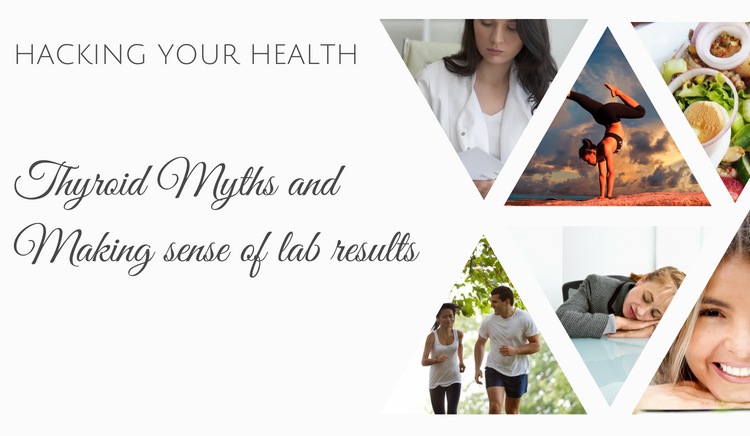
Did your last test results convey that you fall in the normal range but you can’t help but feel that something isn’t right? Are you tired of being told everything is normal yet you feel horrible? Guess what! You are not alone! Today we’re going to talk about one of the most common complaints about lab results – my thyroid hormone results say I am normal but I am losing hair, can’t lose weight, fatigued… You all know what I am talking about, right? I know you do because I am asked this by my clients, in health forums and from friends and family – All The Time! 🙂
So let us first talk about what happens when we have an out of balance thyroid. What are the warning signs of those, and how can we take a preemptive approach to address any sort of potential hormone imbalances? What tests should I be looking at? And finally, how to make sense of the lab results!
When our thyroid hormones are out of balance, a whole cascade of events happens. What many do not realize is that a lot of things have been going on under the surface before the thyroid gets out of balance. So, by the time we see that our hormones are abnormal on the conventional test, there have been a lot of clues that have been missed in the conventional medical world. This is because the tests are not really designed in the conventional world to take a preemptive approach or preventative approach, rather they are to identify a diseased state. Everything leading up to the disease is disregarded.
Does the following sound familiar? You received your test results, head to your health provider and they proceeded to tell you”Everything is normal.”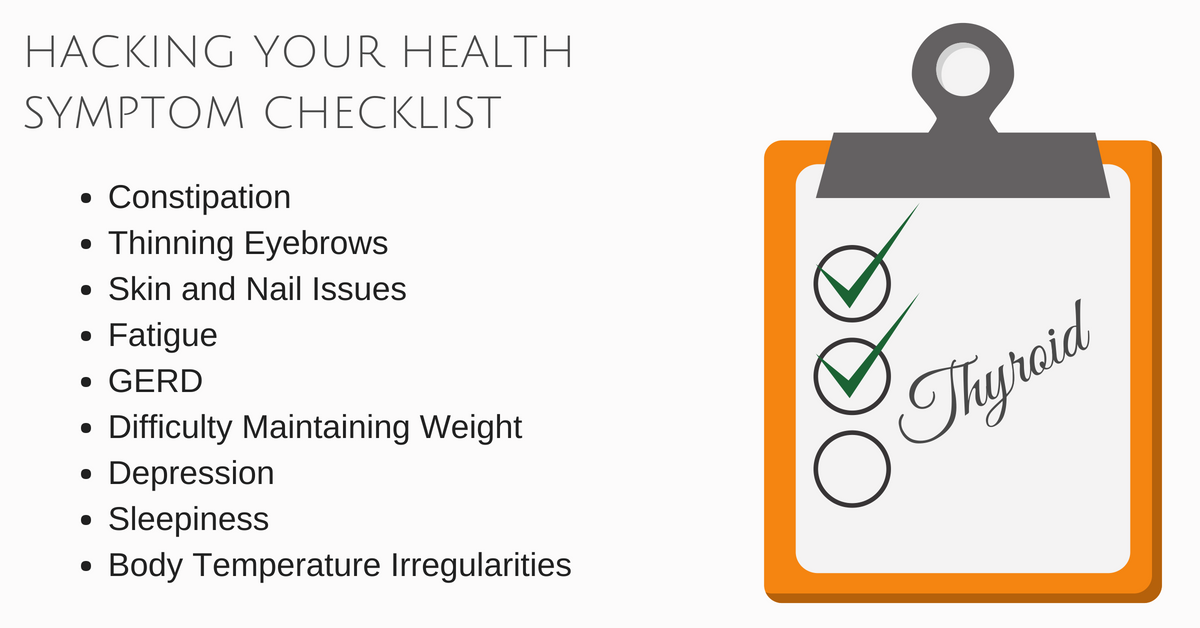
And you are like, “But I feel horrible. How can my test say everything is normal?! I should not feel this way!”
There are two sides to that. So, the first side real quick is that the normal is really what is common, or what is found the most. This is not a range which determines health and vitality. They are looking for a critical state – a disease state. Disease is at the end of the equation – it is what happens after things have broken down to the point a label can be assigned. Until that point it is just chaos happening. This is a very important concept to understand. The conventional model is an acute care – emergent care model – it is not equipped, nor are the providers trained for addressing chronic health issues. So we have to take a different approach to a chronic health situation unless we are content with an acute care outcome – getting a pill, surgery, or other invasive intervention to treat symptoms, not the cause.
The other side of this is to look at the data from a functional perspective and one that looks at values and how they relate to health, vitality, and rejuvenation. Do these ‘normal’ values mean they are healthy values? No, absolutely not. Generally speaking, a middle of the range is usually more of an optimal healthy range. There are exceptions, sometimes it is at one or the other end that is ‘healthy’. But in all instances, we have to put them into context. We have to look at these things differently and approach these test results differently if we want to really take charge of our health, especially to reverse some of these chronic illnesses such as autoimmunity and hormone imbalances.
The quick-reference chart below shows us the factors which contribute to a healthy level and factors which create an unhealthy level.(I will get into more details in a moment) When I see hormonal imbalances the first thing I am going to explore is looking at the co-factors and opportunities for improvement as well as are there other areas which are compromised and shifting the conversion to that sympathetic state?
With that, I note our thyroid is dependent on a healthy GI tract so when our digestive system is compromised for long periods of time, there will be an effect on our hormones. Hormonal imbalances are nearly always downstream from digestive imbalances. Lastly, if we can identify the warning signs we have a much greater potential to head off autoimmunity before it takes over.
This next illustration gives a general overview of the autoimmune process – we need to look at things in the beginning to change the course and direction of our health. When looking at Hashimoto’s or other thyroid imbalances the primary clues are: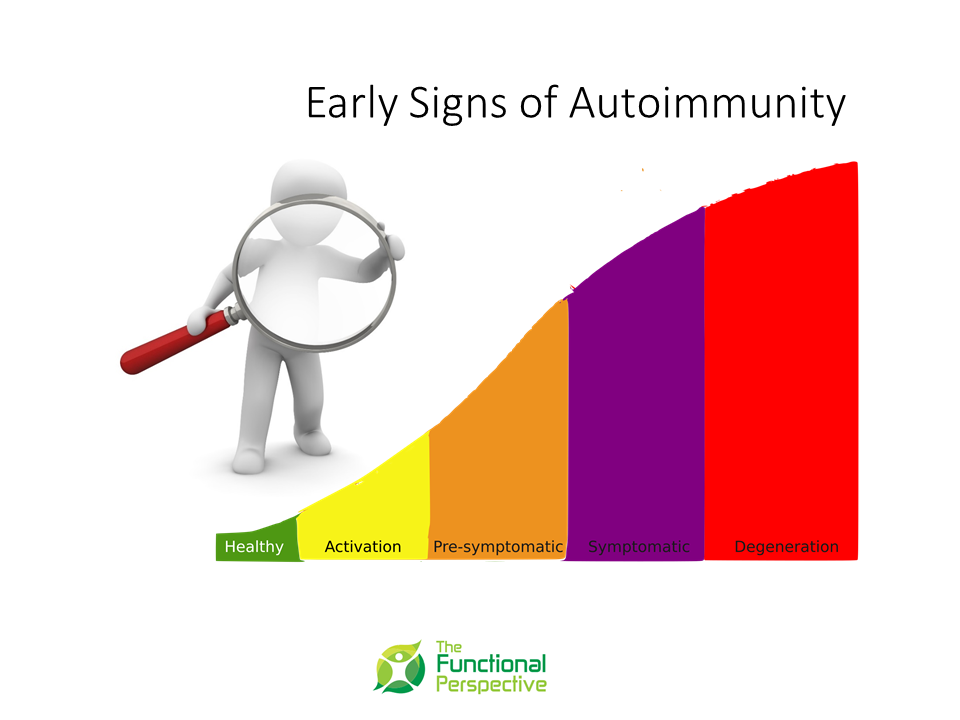
- Fatigue
- Weight gain (or loss in hyperthyroid situations)
- Tired and sleepy
- Difficulty in maintaining body temperature
- Skin issues
- Depression
- Constipation
The thyroid hormones play a huge role in our energy production. In the Activation and Pre-Symptomatic stages is where we see these symptoms start to emerge, or we see things like frequent illness, frequent periods of high-stress, exposure to toxins, pathogens, and other things which elicit an immune response. When don’t have energy, then we are going to be fatigued, we’re going to get irritable, we’re going to have unexplained weight gain. The cycle leads to more and more symptoms. It becomes difficult for us to maintain a healthy weight, and then we are going to be tired even more. We are going to feel cold. Our temperature regulation is going to be off. Many times there’s going to be things such as depression, and dry skin, and even constipation.
So, those are some of the top signs that our body is trying to tell us: “Hey, there’s something going on inside. I have a battle going on and right now the thyroid hormone production, utilization isn’t one that is promoting a parasympathetic, peaceful, rest and digest state”. When we see these clues a thyroid imbalance and autoimmunity, Hashimoto’s, those kinds of things could be on our horizon.
Before we get any further, I want to just talk real quick here about feeling cold, and the temperature regulation irregularities. So, the thyroid it not only helps with our energy, like having energy to do things, but also that energy which translates into our body temperature. That is one of the best ‘tests’ that we have where we see what is going on intracellularly with the thyroid hormones.
All of the lab tests that we have tell us more things are going on outside the cells. There is no test that can get inside the cell and tell us okay, hey, how is this thyroid hormone actually working inside the cell? The intracellular test that we have is our body temperature. When energy is produced there is heat involved in that, that is how we can tell what’s going on intracellularly with our thyroid.
So, of all those things, the checking pf our temperatures can be done at home. You don’t need to go to a doctor for that, we don’t need to go to a lab, or order some special lab. You don’t need insurance for any of that. Just get a really good thermometer. Ideally, the old time mercury type thermometers that you can check your oral temp. You need to hold it for quite a long time. A lot of times the digital ones are not quite as accurate for what we need for that basal temperature.
Charting your temperature, which you can download a chart HERE to help track back to see, hey, do I potentially have some problems here? ![]() There are going to be some fluctuations. There are different patterns that we’re going to see throughout the day of high and low, but there still is a good healthy range that we should have, and there’s going to also be a range based on what is the difference between your highest and lowest.
There are going to be some fluctuations. There are different patterns that we’re going to see throughout the day of high and low, but there still is a good healthy range that we should have, and there’s going to also be a range based on what is the difference between your highest and lowest.
It’s not just where you’re at on the chart, but how much of a difference in range are you seeing throughout your day. All these things are different clues for us as clinicians to look at. The temperature one is one of the number one things and top of my list that I always explore, and I always ask about whenever I’m looking through history to see, okay, what are the temperatures? What all is going on here because that’s going to tell me more about what’s going on with the thyroid hormones on a cellular level.
Which this leads to the question of Why? I’m always going to ask the question ‘why?’ If we know that we have a temperature that is off, the next question is why is it off? Because just when we get a diagnosis from the conventional world of saying, hey, you’ve got this disease that doesn’t really tell us what really is going on. The diseases are at the end of the equation. What I do, and what those who are approaching health functionally, holistically, and from a naturopathic perspective, we are looking way back at the beginning saying, okay, what are the building blocks and why do we have a problem?
The disease is just a label given by the conventional world so that you can be prescribed medications or a pill or some sort of surgery, something for that. It doesn’t really get to why, and that’s why we come away from our doctor appointments frustrated and spinning in circles. We are trying to fit a square peg in a round hole – it just isn’t going to work!
That’s a whole other topic that I’m not going to get on, but let’s go to the question of why. So, why is there an imbalance, why is there a problem with the energy production? That’s where we’re going to look at several key things. The first thing that we’re going to look at is what is the environment like? This boils down to genetics and epigenetics. We have our genes, and those are the building blocks that we were given. Our genes don’t mean everything we can influence our genes and how they express themselves, and that’s the epigenetics. That’s going to basically be everything around us, the ‘environment’.
This is where the detective work begins and things start to get exciting as we uncover clues and find those long lost missing pieces! We’re going to look at toxins. Are there things that are slowing down our system, that’s making our body have a difficult time in producing hormones? Because the hormones are secondary. Our body has two systems. We have the parasympathetic state, and the sympathetic state. Those epigenetics are going to determine which state our body is going to be in. Is it going to be in that sympathetic state, which is that fight or flight mode? That is the state of our body is running from a lion, it’s going to do whatever it needs to do to get us to safety.
It doesn’t matter if it’s a lion, it doesn’t matter if it’s toxins, it doesn’t matter if it’s somebody at work upset us. All those things engaged our sympathetic state. Our body can perceive a lion. When you see a police car behind you with flashing lights there is a sympathetic response from our body – that surge of hormones that has us wondering – Was I driving too fast? Did I forget to use my turn signal? As soon as they speed on around us we start to return to normal – we return to the parasympathetic, rest digest, repair, and peaceful state. But, how many of you take a while to calm down from a ‘false alarm’? That is a clue about how our body is able to clear out hormones after they have ‘done their job’. When those things linger it creates what I often refer to as a clogged up toilet. Our elimination system is a bit overwhelmed and needs a little support. It is those sort of daily stressors which put our body into that mode that wears heavily on our body. It is those things which our body perceives as a threat and engages our survival mode for extended, or frequently throughout our day that it becomes problematic. This is the beginning of chronic illnesses.
We NEED both states – balance is the key. If we are constantly running from a lion that is problematic, if we DON’T run from the lion – that is just as problematic! When our body is in that fight or flight mode, that’s where it’s going to divert things too. The thyroid is really used for replenishing for that rest and health. There is an energy component, but our body, the adrenals are going to use that stuff much faster than what our body’s going to replenish. And it’s going to divert things from our GI tract to go get us out of danger.
We need blood flow in our GI tract working really well for our hormone production. When we divert things from that, it’s going to change how foods are handled, there’s going to be a domino effect on our hormones, on our neurotransmitters, on how we’re digesting foods. Things such as, are we getting the nutrients from our food to use to make those things? We can’t get the nutrients from our foods if we’re diverting the blood flow from our GI tract.
That is how it gets all intertwined and eventually things fall apart. When we get labeled, and we get shuffled from this specialist to another specialist in the conventional world and they’re looking at things all independently. So, your endocrinologist is not looking at your GI tract to see, hey, are you digesting food? Are you getting your nutrients from your foods so that your body can make these hormones and do those things? No, everything’s put in its own little box and it is all compartmentalized.
With the hormones, whenever we have these thyroid hormones out of balance, we have to look upstream because there are so many things that happen upstream that are going to affect positively or negatively the balance that our body is going to have when it comes to the hormone regulation and thyroid hormone regulation. Some of the other things in the environment that we’re going to look at besides things such as toxins, are there heavy metals, do we have a deficiency in vitamins and minerals? Are there parasites and things that are messing with and disrupting our homeostasis and a healthy balance in our digestive tract?
There are several links below to studies which get into the microbiome and our hormone regulation. Especially how important bile is to maintaining a healthy balance. I always encourage getting on PubMed to find information to help connect the dots on our health challenges. The liver plays an integral role in thyroid hormone regulation. The liver is where conversion happens and where the elimination of toxins and other things which adversely affect thyroid levels. So, if we don’t have our liver working well, and we’re missing what some building blocks that come from our body, we’re not going to have good conversion, and we get into a catch 22 scenario real quick!
As those things go on and on, then the body is now trying to get what it needs from alternate ways and it puts it in that state of stress. Long-term stress keeps it in that sympathetic state, but then it becomes self-perpetuating when that stress, when it keeps going on and on. We were never meant to run continuously from a lion. Either, we ran away for a short distance, got away from the lion, or the lion gets us. But either way, the chase is over. The chase was never meant to go on endlessly.
In our society, especially here in the US, and a lot of these industrialized societies, it’s nonstop that we are going and going and going and going. That wreaks havoc on our body. And that is where we see a lot more chronic health issues. We are putting toxins into our body. We are injecting toxins, we are eating toxins, we are surrounded by toxins, these things disrupt a healthy balance of our hormones.
Those are the questions that we are going to look at to answer that question ‘Why is there a hormone imbalance?” Then we address those things. We’re going to look for opportunities to see where we can say, “Hey, yes, there is this great toxic exposure, we need to eliminate that” or, “We have these nutrient deficiencies. We need to fill those deficiencies.” We always start with the foundation, and we want to make sure that we are getting good quality clean foods which can be very difficult here in the US. It is really important that we are putting in good quality fuel into our bodies just as we would put in good quality fuel into our cars. We would never intentionally put water in our gas tank, and we would never intentionally put tainted gasoline into the gas tank of our cars.
The same thing with our bodies. If we expect our bodies to run optimally, we have to provide it with good fuel, and to clean up anywhere where there are problems. We need to make sure that we are taking care of our body just as we would our vehicle.
One last thing, here is the chart I mentioned earlier that gets into details about the conversion process and factors which contribute to our hormone levels. (You can download this chart here)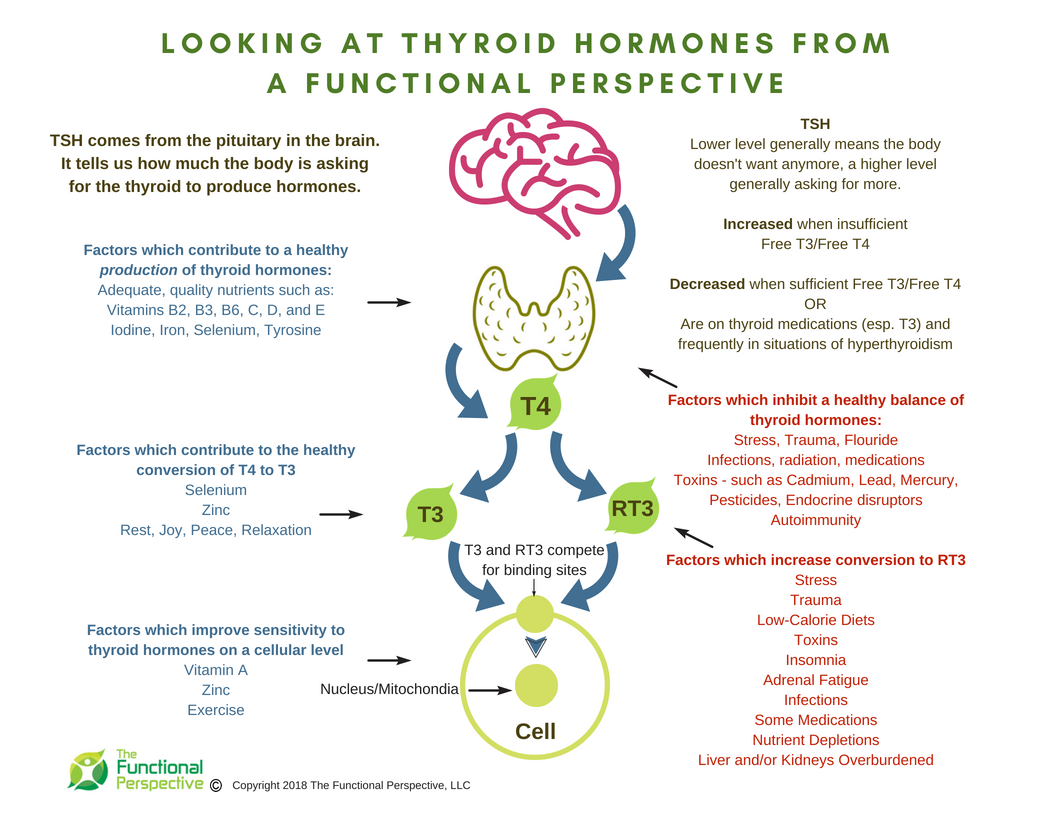
First – we get a signal from our pituitary. When the signal comes it is the body’s way of telling us, hey, I need more T4 hormone or, you know what, I’ve got enough T4.
Then the T4 converts and either heads down the path of T3 or Reverse T3. You can see some of these things that are shunted over to the reverse T3 like the chronic stress. We get into that stressful state, our body is going to put it over to that reverse T3.
Here’s why that is important – because the reverse T3 and the T3, they compete for the binding sites on the cell. So, when we have reverse T3 on the binding site less of the T3 will get through, which equates to our body not being able to produce as much energy. So, we have got to make sure we don’t have too much excess or too much of the reverse T3 because that’s where we’re going to have problems. The tests that I always recommend for those who are having chronic thyroid issues and for those who are just not feeling well, is to say ask your provider for a full thyroid panel. That’s going to be your TSH, which is your thyroid stimulating hormone. It’s going to be your T3, your T4, your free T3, and your free T4. As well as your reverse T3 and total T3. You want the entire gambit plus you’re going to want the antibodies, the TPO antibodies to see, is my body making attacking these thyroid hormones. That’s going to give you a pretty big picture of what’s going on with your thyroid, versus the general test most look at which is TSH.
The TSH is basically like the light switch. Your body saying, hey, yes, I need more, or no, I’ve got enough. So, it’s turning on or off the signal. The lower number actually means that your body is saying, hey, I’ve got plenty. When it’s higher, it’s going to say, you know what, we’re needing more, turn up, we need more. It’s asking for more. It’s a very simple way to look at it. There are other nuances to that, and you really need to put it all in context, but that can get you started to help you look at, to understand a little bit more about what these tests are telling you from a functional perspective.
In closing remember,
- Lab ranges refer to what is commonly found – put your results into context
- Identify healing opportunities – areas where the body is perceiving stress and shift that stressful state to one of healing and restoration
- Areas such as toxic exposures
- Nutrient deficiencies
- Does the digestive tract need support
- The signs and symptoms our body is presenting with are how it communicates needs – listen to that inner voice and your ‘gut’ instinct!
- Reach out to a functional, holistic or naturopathic professional who can help you do the detective work needed to find and put the missing pieces of your health back together!
Now you are equipped to start hacking your health and embark on the journey of re-defining Health’care’! I welcome your comments and questions and be sure to follow me on facebook. For mom’s and women battling with chronic digestive or autoimmunity I have a private facebook group – Moms Taking Charge of Digestive Health you are welcome to drop by!
References:
Fuya Zhao, Jing Feng, Jun Li, Lei Zhao, Yang Liu, Huinan Chen, Ye Jin, Biqiang Zhu, and Yunwei Wei. Alterations of the Gut Microbiota in Hashimoto’s Thyroiditis Patients. Thyroid. Feb 2018. http://doi.org/10.1089/thy.2017.0395
R. Malik, H. Hodgson; The relationship between the thyroid gland and the liver, QJM: An International Journal of Medicine, Volume 95, Issue 9, 1 September 2002, Pages 559–569, https://doi.org/10.1093/qjmed/95.9.559
Virili, C. & Centanni, Does microbiota composition affect thyroid homeostasis? M. Endocrine (2015) 49: 583. https://doi.org/10.1007/s12020-014-0509-2
Vitek L, Haluzik M. 2016. The role of bile acids in metabolic regulation. J Endocrinol 228:R85–R96. https://doi.org/10.1530/JOE-15-0469
Yhojan Rodríguez, Manuel Rojas, M. Eric Gershwin, Juan-Manuel Anaya. Tick-borne diseases and autoimmunity: A comprehensive review, https://doi.org/10.1016/j.jaut.2017.11.007
The most important thing we can do for our health
I came across this on facebook and it is one of my all time favorite posts- hugs are POWERFUL and much needed when dealing with any type of health issue… Have you had your hugs today?
Sensational Tuna Salad
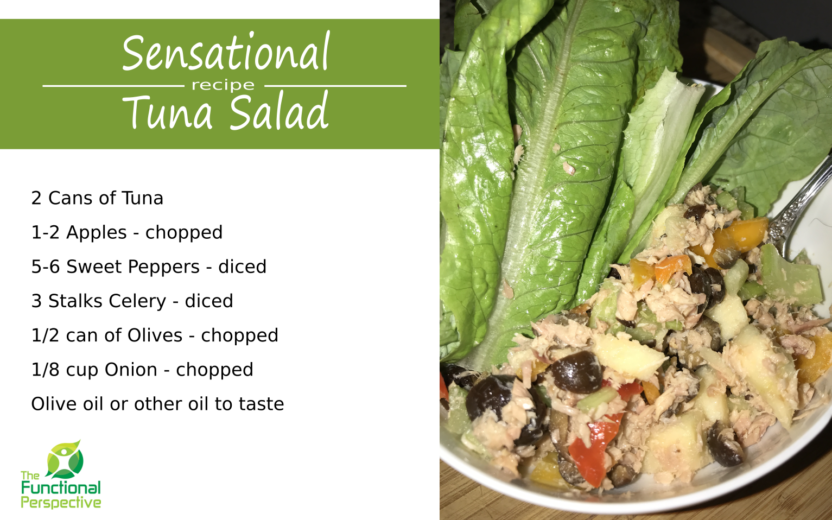
Look what my children surprised me with for lunch today! It was absolutely SENSATIONAL! I think they are ready to use our summer vegetables and couldn’t pass up this colorful, scrumptious combination!
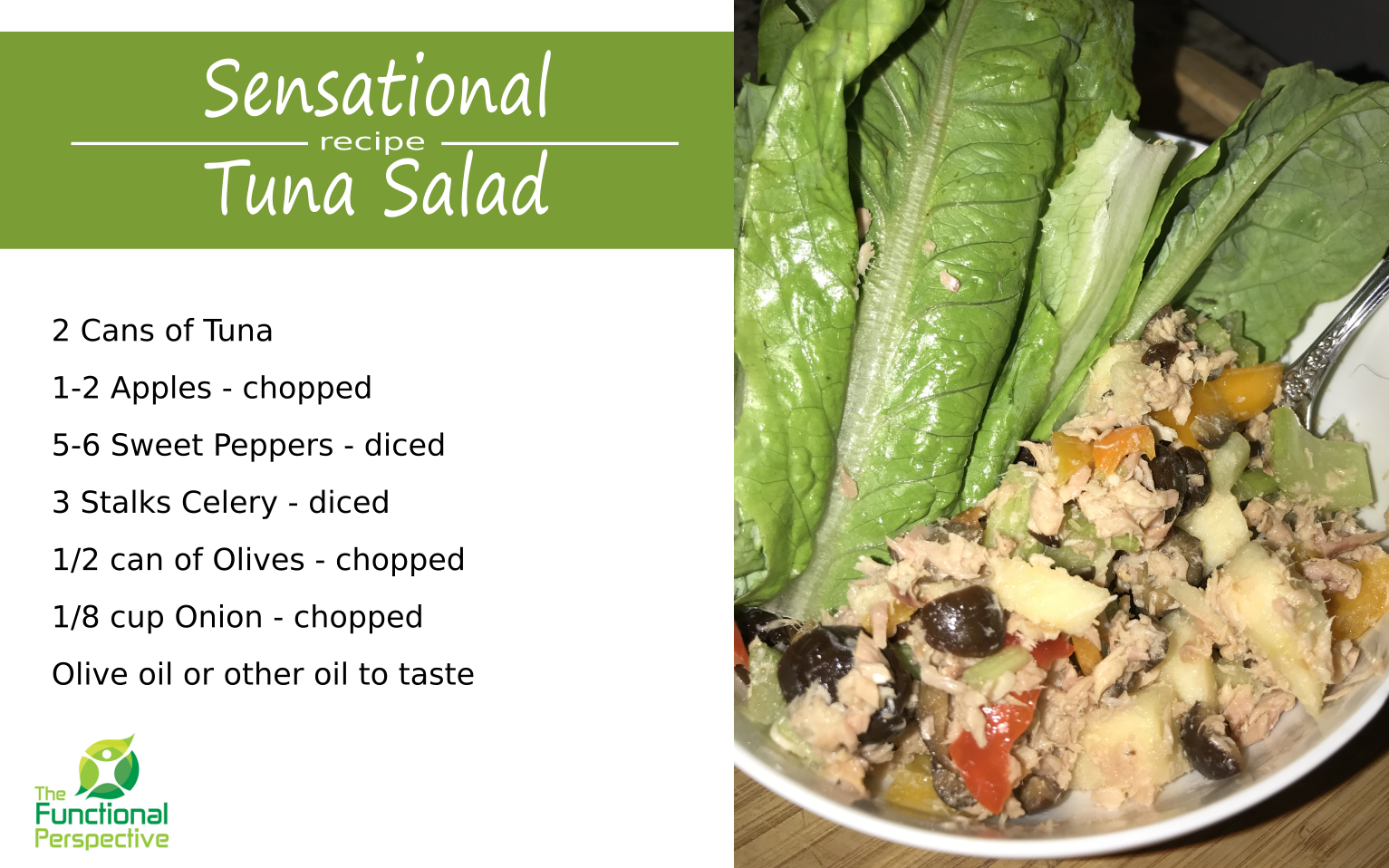
Inspired by: Family original!
[/recipe-notes] [recipe-ingredients] – 2 cans of Tuna
– 1-2 Apples – diced
– 5-6 Sweet Peppers – diced
– 3 Stalks of Celery – diced
– 1/2 can of Olives – chopped
– 1/8 cup of Onion – chopped
– Olive oil or other oil to taste
– optional: Sesame seeds, sunflower seeds, cranberries
[/recipe-ingredients] [recipe-directions] 1. Rinse and chop vegetables and mix all ingredients in a bowl. Serve with lettuce for a great lunch during hot summer months!
[/recipe-directions] [/recipe]
Celiac Disease and Fertility Problems
 [et_pb_section bb_built=”1″ admin_label=”section” transparent_background=”off” custom_padding=”0px|||” _builder_version=”3.0.85″][et_pb_row admin_label=”row” make_fullwidth=”off” use_custom_width=”off” width_unit=”on” use_custom_gutter=”off” custom_padding=”0px|||” custom_margin=”0px|||” allow_player_pause=”off” parallax=”off” parallax_method=”on” make_equal=”off” parallax_1=”off” parallax_method_1=”off” background_position=”top_left” background_repeat=”repeat” background_size=”initial”][et_pb_column type=”4_4″][et_pb_text background_layout=”light” text_orientation=”left” use_border_color=”off” border_color=”#ffffff” border_style=”solid” custom_margin=”0px|||” custom_padding=”0px|||” module_alignment=”left” background_position=”top_left” background_repeat=”repeat” background_size=”initial” _builder_version=”3.0.85″]
[et_pb_section bb_built=”1″ admin_label=”section” transparent_background=”off” custom_padding=”0px|||” _builder_version=”3.0.85″][et_pb_row admin_label=”row” make_fullwidth=”off” use_custom_width=”off” width_unit=”on” use_custom_gutter=”off” custom_padding=”0px|||” custom_margin=”0px|||” allow_player_pause=”off” parallax=”off” parallax_method=”on” make_equal=”off” parallax_1=”off” parallax_method_1=”off” background_position=”top_left” background_repeat=”repeat” background_size=”initial”][et_pb_column type=”4_4″][et_pb_text background_layout=”light” text_orientation=”left” use_border_color=”off” border_color=”#ffffff” border_style=”solid” custom_margin=”0px|||” custom_padding=”0px|||” module_alignment=”left” background_position=”top_left” background_repeat=”repeat” background_size=”initial” _builder_version=”3.0.85″]
If you’ve been trying to have a baby, celiac disease and fertility problems may be standing in your way. It may be hard to believe but celiac disease, which causes an allergy to gluten, can actually lead to fertility problems in both men and women.
The exact reasons aren’t totally clear, but scientists do have some ideas about why fertility and celiac are related. One of the most obvious problems is that celiac disease leads to malnutrition. Celiac disease causes your small intestine to be unable to absorb the nutrients you eat.
If your body isn’t getting the nutrition it needs to function properly, it can affect your hormone levels and your ability to produce and carry a child. This is true for both men and women because it can interfere with either system.
Often, women who have celiac disease have particular problems with their menstrual cycles. If you have celiac disease you may have abnormal periods – they may be absent for long periods of time or you may have problems with frequent bleeding.
Problems with your period indicate that you might not be ovulating regularly and that will interfere with your ability to conceive. If you’re not ovulating, there’s no chance you’ll be able to get pregnant.
In addition, women with celiac disease have a higher risk of having complications in their pregnancy. Those complications include threatened miscarriage (bleeding during pregnancy), actual miscarriage, and high blood pressure.
Pregnant women suffering from celiac also may have problems with anemia. These conditions can make it difficult to carry a pregnancy to term and can cause problems during labor and delivery that threaten both mother and child.
If you have celiac disease, it’s important to let your healthcare provider know when you’re trying to conceive. The good news is that by following a gluten-free diet you can actually reverse the inflammation caused by gluten and you can get your body in a healthy state.
You’ll have the best chances of having successful conception and a healthy pregnancy when you begin with a healthy body. That means that it’s best to have your celiac disease under control before attempting to get pregnant.
The best way to control celiac is through diet. You’ll need to eliminate gluten from the foods you eat. This can be difficult initially, but the improvement in your health condition is worth the effort.
It’s always best to work with your healthcare provider to make sure you receive the proper medical treatment along with your diet. In severe cases of celiac, medical intervention is required. Celiac disease and fertility problems can go hand-in-hand, but you can work to improve your chances of pregnancy.
[/et_pb_text][et_pb_image admin_label=”Autoimmune Blog Ad 1″ saved_tabs=”all” global_module=”2852″ src=”https://thefunctionalperspective.com/wp-content/uploads/2017/04/blog-ad850x200.jpg” show_in_lightbox=”off” url=”https://thefunctionalperspective.com/lm/autoimmune-diseases/” url_new_window=”on” use_overlay=”off” animation=”off” sticky=”off” align=”left” force_fullwidth=”off” always_center_on_mobile=”on” _builder_version=”3.0.85″ show_bottom_space=”on” /][et_pb_text _builder_version=”3.0.85″ background_layout=”light”] [social_warfare] [/et_pb_text][/et_pb_column][/et_pb_row][/et_pb_section]Foods That Can Help Boost Your Immune System
 [et_pb_section bb_built=”1″ admin_label=”section”][et_pb_row admin_label=”row” background_position=”top_left” background_repeat=”repeat” background_size=”initial”][et_pb_column type=”4_4″][et_pb_text background_position=”top_left” background_repeat=”repeat” background_size=”initial” _builder_version=”3.2.1″]
[et_pb_section bb_built=”1″ admin_label=”section”][et_pb_row admin_label=”row” background_position=”top_left” background_repeat=”repeat” background_size=”initial”][et_pb_column type=”4_4″][et_pb_text background_position=”top_left” background_repeat=”repeat” background_size=”initial” _builder_version=”3.2.1″]
A number of foods have been found to benefit the immune system in a range of ways. One group of foods is thought to reduce inflammation in the body, leading to less wear and tear on all your bodily systems, including your immune system. Adding anti-inflammatory foods is thought to prevent disease, or reduce the more severe symptoms in those who are suffering from certain health issues, such as arthritis and inflammatory bowel disease.
Another group of foods has been found to trigger inflammation, so avoiding these foods can also provide relief from a range of troublesome symptoms, including allergic reactions such as eczema, asthma, gluten sensitivity and lactose intolerance. These allergies are obvious examples of how inflammation can affect anyone’s health. Avoiding inflammatory foods has shown clear benefits in relation to heart disease and all forms of arthritis, particularly rheumatoid arthritis (RA).
The third group of foods that can boost the immune system to prevent disease and enhance health are known as antioxidants. The normal wear and tear on our bodies every day as a result of stress, the environment, unhealthy foods we eat, smoking cigarettes, and so on, is called oxidative stress. It is thought to be a major cause of aging in the body.
Antioxidants are so named because they combat oxidative stress, thus decreasing the wear and tear on the body and reducing the effects of aging. Some antioxidants are so powerful, they have even been associated with cancer prevention.
Eating more anti-inflammatory foods while cutting back on inflammatory ones, and adding delicious antioxidants to your diet, is the best way to boost your immune system, reduce the effects of aging, and prevent disease. So, which are the best foods to eat, which are the best to avoid, and which foods are the best sources of antioxidants? We will list the top 10 for each category below.
Top 10 to Eat, to Reduce Inflammation
1-Salmon and Other Fatty Fish with Omega-3s
2-Probiotics, found in cultured foods like yogurt and kefir
3-Olive Oil
4-Sour Cherries
5-Walnuts and other tree nuts
6-Peppers
7-Ginger
8-Turmeric
9-Green leafy vegetables and cruciferous (pronounced CREW-sif-er-us) vegetables like broccoli and bok choy (Chinese cabbage)
10-Berries such as blueberries
Top 10 to Avoid If You Wish to Reduce Inflammation
1-Sugar
2-Salt
3-Standard Cooking Oils
4-Trans fats
5-Red Meat
6-Processed Meats/cold Cuts
7-Refined Carbohydrates
8-Artificial Sweeteners and Flavorings, such as aspartame and saccharin; Monosodium Glutamate (MSG)
9-Alcohol
10-Dairy Products
Top 10 Foods with the Highest Level of Antioxidants
1-Small red beans
2-Blueberries, wild
3-Red kidney beans
4-Pinto beans
5-Blueberries, cultivated
6-Cranberries
7-Artichokes
8-Blackberries
9-Raisins
10-Raspberries
It may seem overwhelming at first to make changes to your diet, especially if many of your favorites are on the foods to avoid list. Fortunately, a little effort can go a long way towards improving your immune system if you make healthy substitutions.
For example, if you love sweet, sugary foods, use more fruit to curb your cravings. Blueberries and raspberries can be eaten fresh or cooked as part of a healthy dessert. In our house we buy them frozen when they are on sale in the supermarket and eat them frozen in place of ice cream or another more fattening dessert. We add fresh ones to a range of recipes, from fruit salad to interesting sauces and rice pilafs.
If you are a meat eater, eating fish for 2 meals a week and beans such as the antioxidant-rich red kidney beans or pintos is easy and tasty too. Have fun looking up new recipes and exploring cuisines from around the world. For example, these beans are perfect for Mexican or Tex-Mex cookery. Many of the foods on the anti-inflammatory list are ideal for Chinese or Indian recipes.
Use these three lists to boost your immune system, and see how you can eat better than ever while fighting disease.
[/et_pb_text][et_pb_image admin_label=”Autoimmune Blog Ad 1″ saved_tabs=”all” src=”https://thefunctionalperspective.com/wp-content/uploads/leadmagnets/LM-blog-autoimmunity2.jpg” show_in_lightbox=”off” url=”https://thefunctionalperspective.com/lm/hashimotos-disease” url_new_window=”off” use_overlay=”off” animation=”off” sticky=”off” align=”left” force_fullwidth=”off” always_center_on_mobile=”on” use_border_color=”off” border_color=”#ffffff” border_style=”solid” global_module=”2852″ animation_style=”none” animation_duration=”1000ms” animation_intensity_slide=”50%” show_bottom_space=”on” /][et_pb_text _builder_version=”3.2.1″] [social_warfare] [/et_pb_text][/et_pb_column][/et_pb_row][/et_pb_section]How Probiotics Can Help Your Immune System
 [et_pb_section bb_built=”1″ admin_label=”section”][et_pb_row admin_label=”row” background_position=”top_left” background_repeat=”repeat” background_size=”initial”][et_pb_column type=”4_4″][et_pb_text background_position=”top_left” background_repeat=”repeat” background_size=”initial”]
[et_pb_section bb_built=”1″ admin_label=”section”][et_pb_row admin_label=”row” background_position=”top_left” background_repeat=”repeat” background_size=”initial”][et_pb_column type=”4_4″][et_pb_text background_position=”top_left” background_repeat=”repeat” background_size=”initial”]
By now, almost everyone has heard of probiotics, the active cultures in a range of dairy products such as yogurt, some cheeses and kefir, and in fermented foods such as miso, kimchi and sauerkraut. Most of these are tasty additions to our diet that can also help improve our overall digestive health. But can they also boost the immune system?
Studies have shown that adding probiotics to your diet conveys a range of benefits for people of all ages, as well as unborn children and those who are nursing. Some of the most commonly studied strains promote T cells and the so-called Killer cells. Some of the immune cells triggered also appear to have cancer-fighting properties.
Probiotics taken by women during pregnancy appear to affect the immune system of the unborn infant. Taken in childhood, probiotics appear to help young children avoid immune-mediated diseases such as asthma, eczema, colds, and type 1 diabetes.
The effects of probiotics are well-documented in relation to improving digestive health in a number of ways. Probiotics can balance the effects of antibiotics, which are taken in order to rid the body of bacteria.
Antibiotics can be helpful, but unfortunately they are not selective; they kill both harmful and helpful bacteria at the same time. Probiotics can add back the helpful bacteria and also boost the level of immune cells in the mucous membranes of the intestines.
In one study on probiotics, immune function, infection and inflammation in the body, probiotics stimulated a range of antibodies. Probiotics such as lactobacilli and bifidobacteria was found in children to reduce the incidence and duration of diarrhea. They can also reduce the risk of travelers’ diarrhea in adults.
The effect of may benefit children and adults with irritable bowel syndrome and adults with ulcerative colitis; studies with reference to probiotics’ benefits in relation to Crohn’s Disease are not clear as of yet. Probiotics have little effect in rheumatoid arthritis, but they can help with dermatitis and other allergic reactions.
Many people who are lactose intolerant might think they have to miss out on probiotics because they are so commonly found in dairy products. The good news is that fermented foods such as miso, tempeh (fermented soy) and sauerkraut can all add healthy probiotics to your diet.
If you have been ill lately and taking antibiotics, add some probiotics to your diet and see what a difference they can make to your health.
[/et_pb_text][et_pb_image admin_label=”Autoimmune Blog Ad 1″ saved_tabs=”all” src=”https://thefunctionalperspective.com/wp-content/uploads/leadmagnets/LM-blog-autoimmunity2.jpg” show_in_lightbox=”off” url=”https://thefunctionalperspective.com/lm/hashimotos-disease” url_new_window=”off” use_overlay=”off” animation=”off” sticky=”off” align=”left” force_fullwidth=”off” always_center_on_mobile=”on” use_border_color=”off” border_color=”#ffffff” border_style=”solid” global_module=”2852″ /][et_pb_text _builder_version=”3.0.85″ background_layout=”light”] [social_warfare] [/et_pb_text][/et_pb_column][/et_pb_row][/et_pb_section]Myths and Facts About Boosting Your Immune System
 [et_pb_section bb_built=”1″ admin_label=”section”][et_pb_row admin_label=”row” background_position=”top_left” background_repeat=”repeat” background_size=”initial”][et_pb_column type=”4_4″][et_pb_text background_position=”top_left” background_repeat=”repeat” background_size=”initial”]
[et_pb_section bb_built=”1″ admin_label=”section”][et_pb_row admin_label=”row” background_position=”top_left” background_repeat=”repeat” background_size=”initial”][et_pb_column type=”4_4″][et_pb_text background_position=”top_left” background_repeat=”repeat” background_size=”initial”]
There are a lot of theories on how to boost the immune system to ward off diseases, particularly in reference to cold and flu season, when people are most concerned with avoiding illness when everyone around them seems to be sick.
But is there any truth in these theories? Let’s look at a few of the most common myths about your immune system, and the facts you need to stay healthy all year round. Are they true or false?
Eating more fruits and vegetables can keep your immune system strong.
True. It is not simply an old wives’ tale that you should eat your fruits and veggies. Studies have shown that people who eat them regularly tend to be healthier than those who do not. They offer a range of nutrients that can help your immune system fight viruses and bacteria. Try to eat a rainbow every day in order to consume a variety of antioxidants, which help fight disease, and phytochemicals, plant-based nutrients.
Vitamins and supplements can help ward off disease and make you feel better faster.
False. A good daily multivitamin can help fill in any gaps in an otherwise healthy diet, but it is no substitute for high-quality nutrition from a range of all-natural foods. Many people take high doses of Vitamin C to ward off colds. However, this is not really of great benefit because Vitamin C is water-soluble, which means the body cannot store it and it is eliminated from the body through the urine. Vitamin A is important to the immune system, but it is fat soluble, which means it can be stored in the body. Too much, however, can lead to Vitamin A toxicity.
Many companies are now selling cold prevention remedies with zinc in them, which promise to ward off colds, or relieve symptoms more rapidly. Many of them are used in the nostrils. While some of these products have been shown to have some benefit in warding off colds, they have also been shown to cause potentially permanent loss of smell. Plus, not all colds and flu enter the body through the nose.
Getting enough sleep can boost your immune system.
True. There’s a strong link between sleep and a healthy immune system. The main point to remember is that it should be high-quality sleep, that is, sleep deep enough to offer the body and mind refreshment and healing. Most studies agree that the average adult need 8 hours a night. However, recent studies have also shown that sleeping too much can have a negative effect on your health.
Occasional insomnia should not be an issue, but if it becomes chronic, you should take steps to improve the quality and duration of your sleep. Otherwise, sleep deprivation can lead to you feeling run down, leaving your immune system weakened and you vulnerable to disease. Get into a good sleep routine of regular bedtimes and rising times, and see what a difference it can make to your health.
Covering your mouth when you cough can keep germs at bay.
False. This can help you stop the spread of illness, but do little to help you ward off illness unless everyone in your household and immediate environment does the same. Don’t forget that viruses like cold and flu germs can also survive on a range of surfaces such as doorknobs, phones, countertops and more. Wash your hands often and avoid touching your face, especially nose, mouth and eyes.
A positive mindset can boost your immune system.
True. A good outlook may be good for your health. One study of law students showed that their immune system was directly affected by their thoughts about their studies. If they felt things were going well, they had a better immune system. When they were worried, their immune system slowed. Therefore, looking on the bright side is not just good for you mental health, but your physical health as well.
Now that you’ve separated myth from fact in relation to your immune system, use what you’ve learned really works to help strengthen yours to ward off disease.
[/et_pb_text][et_pb_image admin_label=”Autoimmune Blog Ad 1″ saved_tabs=”all” src=”https://thefunctionalperspective.com/wp-content/uploads/leadmagnets/LM-blog-autoimmunity2.jpg” show_in_lightbox=”off” url=”https://thefunctionalperspective.com/lm/hashimotos-disease” url_new_window=”off” use_overlay=”off” animation=”off” sticky=”off” align=”left” force_fullwidth=”off” always_center_on_mobile=”on” use_border_color=”off” border_color=”#ffffff” border_style=”solid” global_module=”2852″ /][et_pb_text _builder_version=”3.0.85″ background_layout=”light”] [social_warfare] [/et_pb_text][/et_pb_column][/et_pb_row][/et_pb_section]New Link Found Between the Brain and Your Immune System
 [et_pb_section bb_built=”1″ admin_label=”section”][et_pb_row admin_label=”row” background_position=”top_left” background_repeat=”repeat” background_size=”initial”][et_pb_column type=”4_4″][et_pb_text background_position=”top_left” background_repeat=”repeat” background_size=”initial”]
[et_pb_section bb_built=”1″ admin_label=”section”][et_pb_row admin_label=”row” background_position=”top_left” background_repeat=”repeat” background_size=”initial”][et_pb_column type=”4_4″][et_pb_text background_position=”top_left” background_repeat=”repeat” background_size=”initial”]
A new study has just revealed a startling hidden connection between the brain and the immune system. Researchers always assumed that there was no lymph system in the brain. Now they have discovered lymphatic pathways hidden deep inside the brain that can help explain how the brain works with the immune system, which in turn protects the brain,
The lymph system is a network of lymph nodes, ducts, vessels and organs which move lymph from the tissues into the bloodstream. Lymph is a whitish fluid made up of lymphocytes, the cells that attack bacteria in the body, and fluid from the intestines, called chyle (pronounced KYLE), which contains proteins and fats that also help ward off diseases.
The most obvious manifestation of your lymph system is when you get swollen glands in your neck when you become sick with a cold or the flu. They swell up as they gather the resources to fight infection. Lymph nodes also filter harmful cells such as bacteria and cancer cells to stop the spread of disease.
Scientists knew that the brain helped control the immune system, but were not sure how the brain was protected by the immune system until now. The discovery is key because it opens the gateway to a new understanding of inflammation in the brain and body as a whole. It might also reveal the reasons for neurodegenerative disorders such as autism, multiple sclerosis (MS), Alzheimer’s, and other such diseases, offering new hope in the quest to combat illness and the effects of aging on the brain.
Neurological diseases like MS and Alzheimer’s have long been linked to changes in immune system function. Alzheimer’s, for example, is linked with a large build-up of proteins in the brain called amyloid plaques. Mood disorders have also been linked to autoimmune disorders of the digestive tract such as inflammatory bowel diseases (IBD), including Crohn’s disease and inflammatory bowel syndrome (IBS).
It wasn’t always clear how such connections occurred, but now both a gut-brain connection and a pathway from your immune system into your brain have been uncovered. Chyle from the intestines as part of the lymph system therefore has a direct connection to the brain. This means that any imbalance in the intestines has the potential to negatively impact the brain.
Since the lymph system affects every part of the body, including the brain, it is important to do all you can to boost your immune system. The mind-body connection is now better understood and demonstrates that you are what you eat. It also shows how your mood can affect your immune system, and vice versa. Take care of your immune system, and it will take care of you, and your brain, to combat the effects of aging.
[/et_pb_text][et_pb_image admin_label=”Autoimmune Blog Ad 2″ saved_tabs=”all” global_module=”2853″ src=”https://thefunctionalperspective.com/wp-content/uploads/2017/04/blog-ad850x200-1.jpg” show_in_lightbox=”off” url=”https://thefunctionalperspective.com/lm/foods-autoimmune-diseases” url_new_window=”on” use_overlay=”off” animation=”off” sticky=”off” align=”left” force_fullwidth=”off” always_center_on_mobile=”on” _builder_version=”3.0.85″ show_bottom_space=”on” animation_direction=”off” /][et_pb_text _builder_version=”3.0.85″ background_layout=”light”] [social_warfare] [/et_pb_text][/et_pb_column][/et_pb_row][/et_pb_section]